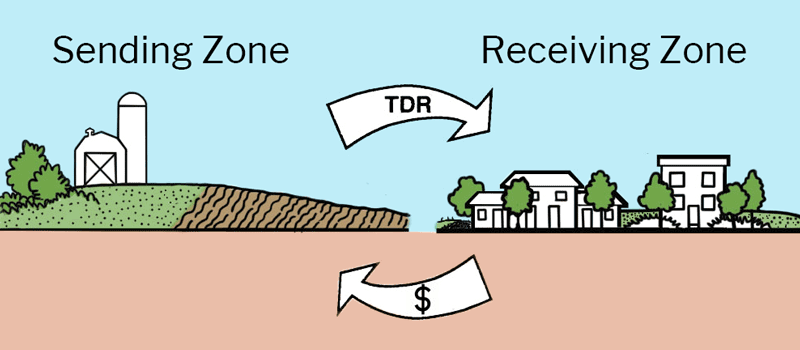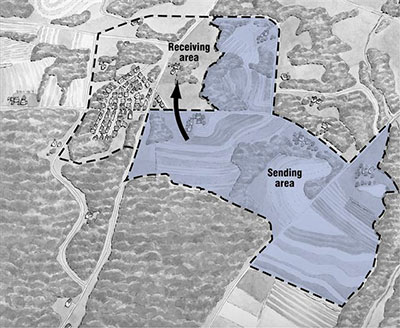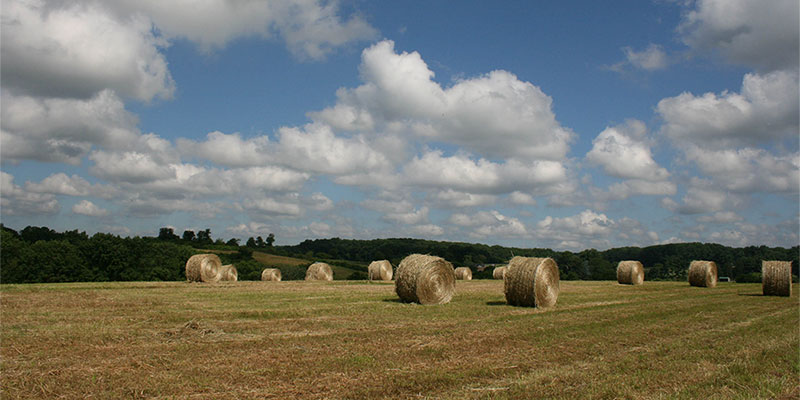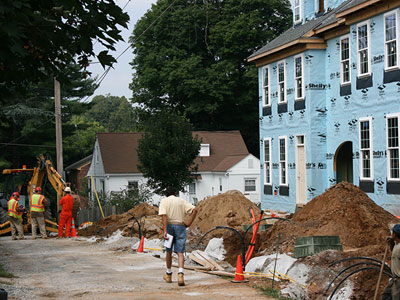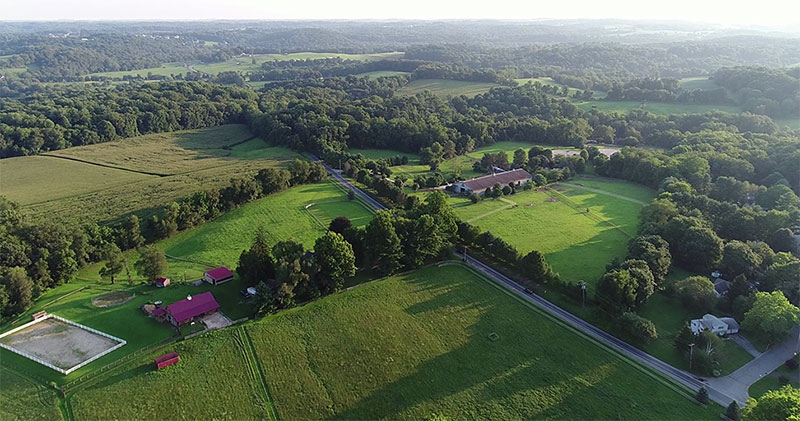Transfer of Development Rights ordinances allow development to be transferred from one part of a community to another.
How it Works
A TDR program separates development rights from a parcel of land that needs protection (the sending parcel) and transfers them to a parcel of land more appropriate for development (the receiving parcel). Through this process, the sending parcel is permanently restricted from development and the receiving parcel is granted a density bonus above what is allowed by its by-right zoning designation. The exchange of rights occurs between private landowners who sell their development rights to developers who have projects located in municipal designated receiving parcels.
Benefits
Value driven
As a market-based tool, TDR compensates the sending parcel’s owner at a “fair market” value and offers increased density and profit potential on the receiving parcel. Owners of sending parcels can maximize the development potential of their land while maintaining ownership and keeping the land open.
Existing Infrastructure Efficiencies
Under a TDR program, development can be directed from undeveloped “greenfield” areas to areas with existing sewer, water, and transportation facilities that can more cost effectively absorb growth.
Open Space Protection
For communities, TDR programs can help protect community character and limit sprawl by preserving important lands with agricultural, environmental, and historic resources.
Implementable at regional levels
Multiple municipalities can participate in TDR programs, which allows cross jurisdictional coordination between mostly rural communities and urban areas.
TDR programs encourage growth where infrastructure like sewer lines and water facilities already exist.
The primary benefit of a TDR program is that it can permanently preserve open space.
With a TDR ordinance, property owners in preservation areas designated as sending zones sell their development rights to developers who are building in growth areas designated as receiving zones.
Get Started
TDR programs are established through the comprehensive plan and by local zoning ordinances. Policy support of TDR should be based on a comprehensive land use analysis that designates areas for preservation and growth. These sending and receiving areas must be clearly identified in the zoning ordinance and on the zoning map. A build-out analysis may be used to determine a balance between sending and receiving areas. TDRs work best when density is sent from Agricultural, Rural and Natural Landscapes to Urban, Suburban Center, Suburban and Rural Center Landscapes. The municipality must determine how to assign development rights to the sending parcel.
Considerations
Voluntary participation
TDR should be offered as an option for land owners, but not be mandated.
Developers in receiving areas buy development rights and are then allowed to use these rights to increase the number of homes they are building on their property.
Additional Municipal Administration
TDR programs require municipal administrative oversight to assign and track rights.
Recording of TDRs
As required by the Pennsylvania Municipalities Planning Code, development rights are required to be conveyed by a deed recorded by the County Recorder of Deeds, after approval of the municipal body.
Adequate Capacity for Increased Density
Municipalities must ensure that additional density the TDR allows on the receiving parcel can adequately be accommodated by existing water and sewer service, transportation facilities, school capacity, etc.
Market Analysis
To be effective, the TDR ordinance must reflect market conditions. This means that the developer in the receiving area must be able to cover the cost of purchasing development rights from the sending area with the value of the new development. When the ordinance is drafted, the municipality should determine the rough value of a sending area development right and the value of additional development in the receiving area for using this development right. This value might by more than one additional home for each development right purchased. In addition, the receiving area should allow development that is desired by the real estate market.
Purchase of Sending Area Development Rights
It can be difficult for developers to buy sending area development rights. Some municipalities buy these development rights and then bank them, selling them to developers as development occurs. Other municipalities have explored the concept of allowing developers to give them money to later use for the purchase of sending area development rights.
Remaining Development Rights
The municipality should determine whether the sending parcel can retain some development rights for limited residential development or agricultural development.
Multi-municipal Applicability
For TDR to be used across municipal borders, a joint municipal zoning ordinance or written agreement among two or more municipalities is required.
Under a TDR ordinance, property owners is sending areas have the right to sell their development rights, but they are not required to sell these rights.
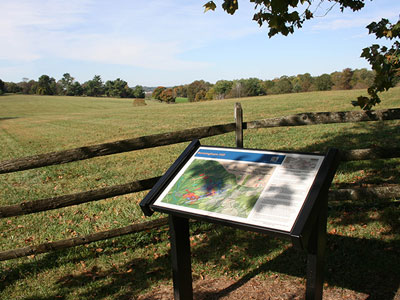
Birmingham Township
Birmingham Township's TDR program provides landowners in the township's agricultural holding area the option of transferring some or all of their development rights. One of the goals of Birmingham’s TDR program is contained in its "purpose" statement in its zoning ordinance: "Provide an equitable way to compensate landowners in the agricultural holding area who voluntarily forbear from developing land considered critical for maintaining the environmental and agricultural values which mark the present land use pattern in the township."
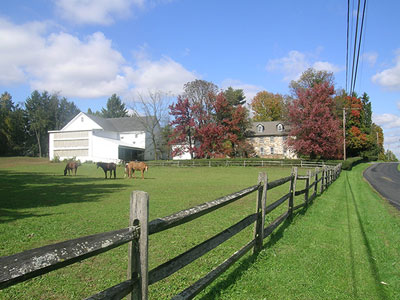
Honey Brook Township and Honey Brook Borough
The township and borough adopted a joint comprehensive plan that establishes the policy framework for their joint TDR program.
Honey Brook Township's Agricultural and Resource Conservation Districts are sending areas, which send development rights into Honey Brook Borough’s Mixed Use Residential and Mixed Use Commercial Districts. Two TDR developments have been approved in Honey Brook Township; the Village Green on Route 322, which is close to being completed and Poplar Realty LP located further north on Chestnut Tree Road.
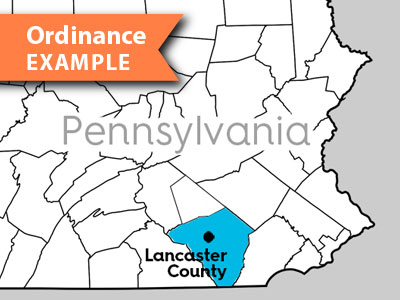
Manheim Township Ordinance, Lancaster County
This program grew out of Manheim Township’s efforts to better manage the patterns and impacts of land development so as to accommodate continued growth while protecting natural resources that are important to the township's residents.
These municipalities in Chester County have adopted TDR programs
- Birmingham Township
- East Nantmeal Township
- East Vincent Township
- Highland Township
- Honey Brook Township and Honey Brook Borough (through a joint comprehensive plan)
- Kennett Township — is currently reviewing a TDR proposal.
- London Grove Township
- Pocopson Township
- South Coventry Township
- West Bradford Township — the township has since removed its TDR provisions
- West Pikeland Township
- West Vincent Township


